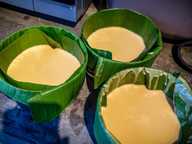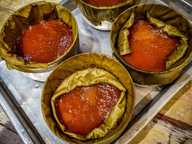



Traditionally served during Chinese New Year, legend says that nian gao is served as a bribe to the Kitchen God (nian gao is sticky, so it will ‘seal’ the God’s lips), so that he will not be able to report bad findings about the family to the Celestial Court. This is Mildred’s take on nian gao—a mix of the modern method (using glutinous rice flour) and the traditional method (long hours of steaming). It also uses a mix of coconut sugar and gula apong, giving the nian gao an extra depth of caramelisation while not being too sweet.
Nian gao with gula apong
by Mildred VoonTraditionally served during Chinese New Year, legend says that nian gao is served as a bribe to the Kitchen God (nian gao is sticky, so it will ‘seal’ the God’s lips), so that he will not be able to report bad findings about the family to the Celestial Court. This is Mildred’s take on nian gao—a mix of the modern method (using glutinous rice flour) and the traditional method (long hours of steaming). It also uses a mix of coconut sugar and gula apong, giving the nian gao an extra depth of caramelisation while not being too sweet.
Servings: 8
Prep time: A project




Servings: 8
Prep time: A project
Ingredients
3 large banana leaves, cut into 6 strips
100g coconut sugar
150g gula apong
350ml filtered water
350g glutinous rice flour
20ml cooking oil
SPECIAL EQUIPMENT:
2 pcs 4″ cake mould
Directions
- Blanch the banana leave strips in boiling water for about 1 minute, or until the leaves soften. Dry the leaves with kitchen paper or a clean tea towel.
- Wrap a cake mould with a piece of leaf. Repeat with another piece of leaf. Cut a round piece of leaf and place it in the centre of the container. Do the same with the other cake mould.
- Whisk the coconut sugar and gula apong into clean filtered water, making sure there are no lumps. Set aside.
- Place the glutinous rice flour in a big mixing bowl. To the flour, gradually stir in the sugar-water mixture and whisk until there are no lumps. The texture should be similar to a thick pancake batter.
- Strain the mixture into the leaf-wrapped cake moulds. Cover the moulds with aluminium foil.
- Place the batter-filled moulds into a steamer basket and place the basket above a pot of boiling water. Steam for about 5 ½ hours.
- After it is done steaming, leave it to cool overnight at room temperature—leave the foil on the moulds.
- The next day, remove the foil. Cover the top of the nian gao with a thin layer of cooking oil. Remove the nian gao from the moulds and trim the leaves or wrap the nian gao according to preference.
- Nian gao can be eaten fresh. It can also be stored for up to 3 days to harden, after which it can be pan-fried with a simple egg batter, or sandwiched between slices of sweet potato and yam to be deep-fried.
Tips
- Keep the nian gao in the fridge so it can last longer.
- This recipe is very flexible in terms of the types of sugar used, as well as the mix of sugars. Refined sugar, brown sugar or gula melaka will work fine. Gula apong, however, makes it a little tangy.
- If a sweeter dessert is preferred, the total weight of sugar can be increased to 300g.
Ingredients
3 large banana leaves, cut into 6 strips
100g coconut sugar
150g gula apong
350ml filtered water
350g glutinous rice flour
20ml cooking oil
SPECIAL EQUIPMENT:
2 pcs 4″ cake mould
Directions
- Blanch the banana leave strips in boiling water for about 1 minute, or until the leaves soften. Dry the leaves with kitchen paper or a clean tea towel.
- Wrap a cake mould with a piece of leaf. Repeat with another piece of leaf. Cut a round piece of leaf and place it in the centre of the container. Do the same with the other cake mould.
- Whisk the coconut sugar and gula apong into clean filtered water, making sure there are no lumps. Set aside.
- Place the glutinous rice flour in a big mixing bowl. To the flour, gradually stir in the sugar-water mixture and whisk until there are no lumps. The texture should be similar to a thick pancake batter.
- Strain the mixture into the leaf-wrapped cake moulds. Cover the moulds with aluminium foil.
- Place the batter-filled moulds into a steamer basket and place the basket above a pot of boiling water. Steam for about 5 ½ hours.
- After it is done steaming, leave it to cool overnight at room temperature—leave the foil on the moulds.
- The next day, remove the foil. Cover the top of the nian gao with a thin layer of cooking oil. Remove the nian gao from the moulds and trim the leaves or wrap the nian gao according to preference.
- Nian gao can be eaten fresh. It can also be stored for up to 3 days to harden, after which it can be pan-fried with a simple egg batter, or sandwiched between slices of sweet potato and yam to be deep-fried.
Tips
- Keep the nian gao in the fridge so it can last longer.
- This recipe is very flexible in terms of the types of sugar used, as well as the mix of sugars. Refined sugar, brown sugar or gula melaka will work fine. Gula apong, however, makes it a little tangy.
- If a sweeter dessert is preferred, the total weight of sugar can be increased to 300g.





